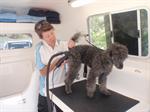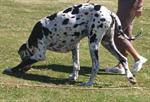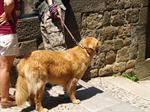 There are business opportunities in the pet care industry now!
There are business opportunities in the pet care industry now!
Pet ownership is increasing every year - recent studies show that ownership has grown from just over half of the population owning pets to now almost two thirds of homes having pet friends to care for. So with our busy lifestyles, pet parents need help to care for their fur babies!
Do you love working with animals? Are you planning to start grooming as a new business? Do you work in the pet care industry already and want to expand your skills?
This course is perfect for you as it:
 introduces grooming techniques with cats, dogs, small animals, large animals
introduces grooming techniques with cats, dogs, small animals, large animals- covers the use of equipment and tools
- teaches anatomy, skin and coat health
- advises how to start a home business as a groomer, follow easy practical business tips
- expands your confidence to work in the showing industry
Get the knowledge, get the skills, get started!
Lesson Structure
There are 9 lessons in this course:
-
Scope and Nature of Grooming
-
Introduction to grooming behaviour
-
Why do humans groom animals?
-
What animals are groomed?
-
Generic grooming tasks
-
Common tools and equipment
-
Combs, brushes, rakes, blades and other equipment
-
Confidently handling animals Introduction
-
The industry and workplace opportunities
-
Workplace skills
-
Accessing the right information online
-
Animal Biology
-
Skin – Epidermis & Dermis
-
Claws, Nails and Spurs
-
Hair
-
Horns
-
Hooves
-
Physiological control – Homeostasis
-
Thermoregulation
-
Caring for the Skin and Coat
-
Animal nutrition
-
General nutrition
-
Micronutrition
-
Water requirements
-
Common skin problems in dogs and cats
-
Ringworm – fungal infection
-
Flea and flea control
-
Ticks and tick control
-
Lice and control
-
Mites (mange) and control
-
Treating skins problems in dogs and cats
-
Common skin problems in equines
-
Caring for the coat – brushing, bathing, blow-drying, dematting, clipping, trimming
-
Removing burrs from fur
-
Caring for cats – combing, brushing and bathing
-
Specialised Grooming Tasks
-
Risks of working with animals
-
Selecting a suitable grooming location
-
Understanding animal psychology and behaviour
-
The flight or fight response
-
Environmental Influence on behaviour in zoo animals
-
General considerations when handling animals
-
Pre-restraint techniques
-
Physical restraint
-
Medical restraint – sedation
-
Safely handling different animals when grooming: dogs, cats, cattle, poultry, rabbits, captive wildlife
-
Handling Horses: Safe and Respectful
-
Catching, releasing, leading, tying up and working around the horse
-
Indicators of pain, mild fear and extreme fear
-
Transporting horses
-
Handling Animals
-
Risks of working with animals
-
Selecting a suitable grooming location
-
Understanding animal psychology and behaviour
-
The flight or fight response
-
Environmental Influence on behaviour in zoo animals
-
General considerations when handling animals
-
Pre-restraint techniques
-
Physical restraint
-
Medical restraint – sedation
-
Safely handling different animals when grooming: dogs, cats, cattle, poultry, rabbits, captive wildlife
-
Handling Horses: Safe and Respectful
-
Catching, releasing, leading, tying up and working around the horse
-
Indicators of pain, mild fear and extreme fear
-
Transporting horses
-
Grooming Dogs
-
Communication in dogs
-
Use of scent
-
Barking & body language
-
Grooming different types of dogs
-
Long Coat types
-
short coat types
-
single coat types
-
Double coat types
-
Smooth coat types
-
Wire haired coat types
-
Woolly or wavy coat types
-
Corded coat types
-
Bald or hairless coat types
-
Brushing and bathing care
-
Clipping and styling
-
Grooming procedures that can go wrong
-
Cutting toenails too short
-
Cuts or nicks when clipping
-
Overheating
-
Water trapped in the ear canal
-
Grooming Exotic Animals
-
Grooming birds
-
Handling birds
-
Beaks
-
Feathers
-
Bathing birds
-
Grooming rabbits
-
Handling
-
moulting
-
Transporting
-
Grooming captive wildlife
-
Bathing small and large mammals
-
Handling large animals and exotics
-
Dangerous animals
-
Fear of humans
-
Issues with handling animals
-
Psychological effects of different handling techniques
-
Grooming areas
-
Safety in Grooming Workplace
-
Safety for people and staff – workplace health and safety
-
First aid
-
Legislation and duty of care
-
Safety of animal owners and visitors to the premises
-
Protective equipment
-
A groomer's personal protection
-
Equipment and workplace safety
-
Storage and disposal of chemicals
-
Handling Tools and Machinery
-
Safety with tools and equipment
-
Safety audit
-
Example of an audit checklist
-
Safety for animals and people
-
Transportation
-
Safety of the animal at the salon
-
Electrical safety – at home and the groomers
-
Slip risk – wet surfaces
-
Cat and dog allergies
-
Preparing for Showing
-
What is animal showing?
-
Why do people show pets?
-
Showing dogs
-
Training your show puppy
-
Preparing for show – dogs
-
Days and evening before the show
-
The day of the show and in the ring
-
Showing – dress to impress
-
Showing poultry
-
Getting started – selecting your breed and buying your birds
-
Preparing birds for show
-
The day before the show
-
The day of the show
-
Showing cattle
-
Preparing cattle for show
-
In the show ring on the day
-
The Business of Grooming
-
Planning a new grooming business
-
The business plan
-
Financial planning
-
Long term goals
-
Medium term goals
-
Annual financial plan
-
Financial records
-
Commonly used finance related terminology
-
Cash flow
-
Make the business a success – know your market
-
Insurance and risks – risk analysis and managing risk
-
Groomers insurance

DIFFERENT DOGS HAVE DIFFERENT COAT TYPES
There are many different coat types in dogs; there are short coats, medium coats, long coats, double-coats and even bald breed dogs. The coat type of each dog will determine how you will groom it and what tools you use.
Long Coat Types
Long coats require a lot of grooming maintenance, the biggest problem faced with long hair is keeping them free from mats and tangles. Examples include e the Collie (Rough) or the Saint Bernard. It is harder to detect ticks, fleas and unhealthy skin conditions in long coat types. Long coat types can get matting around the anus which leads to hygiene and health problems. These are just some of the reasons why a good grooming routine is especially important in long coat type breeds.
Short Coat Types
Short Coat Types such as the Jack Russell or the Staffordshire terrier require less grooming than the long coat types and have less problems with matting, however they still require the removal of dead hairs and debris with regular brushing.
 Single Coat Types
Single Coat Types
Dogs with single coats have the outer guard hairs, but lack the thick undercoat layer. Note that single layer coats should never be groomed when their coats are dry as this can cause the coats to break. To overcome this it is best to spray the coat first with a detangling solution, water or a conditioner spray then brush the coat.
Double Coat Types
Double coated dog breeds were developed in working dogs that were bred to remain outside to work no matter what the weather conditions. This is why double coats are so common in working dog breeds. They consist of a thick inner layer called an undercoat and an outer layer of guard hairs. They include the Old English sheepdog and the Samoyed.
Smooth Coat Types
This coat types are sleek and shiny in appearance; it looks more like skin than a coat. These include Great Danes and the Staffordshire bull terrier. These breeds require less grooming than most other coat types however they do need regular brushing with a bristle brush every few days to evenly distribute the natural oils of the coat and remove dead hairs and debris.
Wire Haired Coat Types
These coats tend to be bristly and course. Examples include German Wire-Haired Pointer and Fox Terrier Wire Coat. These require brushing about twice a week with a firm bristle brush. These breeds may require occasional hand plucking or striping of straggly hairs. Stripping is the removal of the dead undercoat from the rest of the dog’s coat. It is usually required in the grooming of wire haired coat dog breeds.
 Woolly or Wavy Coat Types
Woolly or Wavy Coat Types
These are the curly coat types, such as the Poodle or the Curly Coated Retriever. The wavy and woolly coat types can easily become tangled so they require regular brushing, as they are also prone to dryness and require a conditioner or de-tangling spray to be applied to the coat before brushing to avoid breakage.
Corded Coat Types
These are curly coat types that are allowed to mat and form ‘cord’, similar to dread lock. They were designed to form a weather resistant shield to herding and hunting breeds, such as the Komondor and the Hungarian Puli. They require regular baths to keep their coats clean and remove odours. They require thorough drying after bathing as moisture gets trapped in the tight dreadlocks.
Bald or Hairless Coat Types
Bald or hairless breeds lack hair over most their bodies, they may however have a crest on the head or other tufts of hair i.e. on their paws or tail. They include the Chinese Crested and the American Hairless Terrier. Even though they are mostly hairless they still have grooming needs, they require regular bathing and moisturizing to avoid the skin drying out. They also require sunblock to protect them from sunburn when outdoors.
